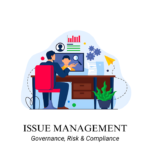Introduction
Laws, Compliance, and Regulatory Tracking is a crucial functionality within Governance, Risk, and Compliance (GRC) management tools, designed to help organizations stay current with relevant laws, regulations, and compliance standards that impact their operations. Effective tracking of these elements is vital for organizations to ensure they are meeting legal requirements, minimizing risks associated with non-compliance, and maintaining operational integrity in a dynamic regulatory environment.
This functionality within a GRC tool provides a centralized platform for tracking sector-specific laws, understanding compliance obligations, and managing updates to regulations. By automating the process of monitoring changes in the regulatory landscape, GRC tools help organizations ensure that they are consistently meeting compliance standards and are prepared to adapt quickly to any changes in the legal environment.
CHECK MORE: Guide to find best Governance Risk and Compliance tools for lawyers
Features of Laws, Compliance, and Regulatory Tracking
Sectoral Relevance
Definition: Sectoral relevance refers to the identification and categorization of laws and regulations that specifically apply to an organization’s industry or sector. This feature within a GRC tool ensures that the organization is aware of and focuses on the regulations that are most pertinent to its operations.
Purpose: The purpose of sectoral relevance is to help organizations understand which laws and regulations are specifically applicable to their industry, enabling them to focus their compliance efforts on the most relevant requirements. By categorizing regulations based on sector, a GRC tool helps organizations prioritize their compliance strategies and avoid the pitfalls of overlooking critical regulatory obligations.
Use Case: A healthcare organization uses the sectoral relevance feature in its GRC tool to identify regulations such as HIPAA and HITECH that specifically apply to the handling of patient data. By focusing on these sector-specific regulations, the organization ensures that its policies and procedures are aligned with the most relevant compliance requirements.
Benefits:
- Ensures that organizations focus on the most relevant regulations for their industry.
- Helps prioritize compliance efforts based on sector-specific requirements.
- Reduces the risk of overlooking critical regulations that could impact operations.
- Enhances the organization’s ability to stay compliant by concentrating on sector-specific laws and standards.
Compliance Applicability
Definition: Compliance applicability refers to the process of determining which laws, regulations, and standards apply to an organization based on its operations, geographic presence, and business activities. This feature within a GRC tool helps organizations identify their specific compliance obligations and ensures that they understand the legal requirements that they must meet.
Purpose: The purpose of compliance applicability is to ensure that organizations are aware of all the legal and regulatory requirements that apply to their operations. By mapping out compliance obligations based on the organization’s activities and locations, a GRC tool helps ensure that the organization is not only compliant with current regulations but also prepared for any changes in their compliance landscape.
Use Case: A multinational technology company uses the compliance applicability feature in its GRC tool to identify which data privacy laws apply to its operations in different countries, such as GDPR in Europe and CCPA in California. This ensures that the company complies with all relevant regulations across its global footprint.
Benefits:
- Provides a clear understanding of which regulations apply to an organization’s specific operations and locations.
- Ensures comprehensive compliance by identifying all applicable laws and standards.
- Reduces the risk of non-compliance by ensuring that all legal obligations are understood and met.
- Supports global operations by managing compliance across multiple jurisdictions
Law and Compliance Updates
Definition: Law and compliance updates refer to the continuous monitoring and management of changes in laws, regulations, and compliance standards. This feature within a GRC tool ensures that organizations are kept up-to-date with the latest legal requirements and can adapt their policies and procedures accordingly.
Purpose: The purpose of law and compliance updates is to ensure that organizations remain compliant in a constantly changing regulatory environment. By providing timely updates on changes to laws and regulations, a GRC tool helps organizations respond quickly to new compliance requirements, minimizing the risk of non-compliance and associated penalties.
Use Case: A financial institution uses the law and compliance updates feature in its GRC tool to track changes in anti-money laundering (AML) regulations. The tool alerts the compliance team whenever a new regulation is enacted or an existing regulation is amended, allowing the institution to update its policies and training programs accordingly.
Benefits:
- Ensures that organizations stay current with changes in laws and regulations.
- Helps avoid non-compliance by providing timely alerts on regulatory updates.
- Supports proactive compliance management by allowing organizations to adapt quickly to new requirements.
- Reduces the risk of penalties and legal action by ensuring that policies and procedures are always aligned with the latest regulations.
CHECK OUT GRC TOOLS ON DIRECTORY OR CLICK HERE

